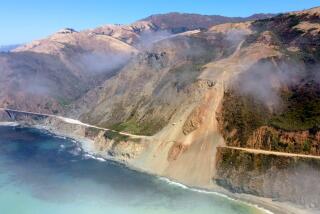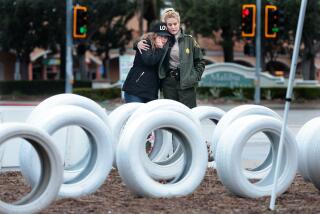Caltrans Institutes Safeguards Along Dangerous Road
- Share via
Caltrans committed Tuesday to placing more police patrols and instituting other safeguards on California 126, bowing to pressure from the public and elected officials for increased safety measures on the hazardous roadway.
The reaction from the state Department of Transportation came after public outrage mirrored a mounting death toll on the highway.
Eleven people have died on the stretch of road between Santa Paula and the Golden State Freeway in the last five weeks, including a pair of fatalities Saturday. Much of the concern has focused on two road-widening projects east of Fillmore that are ultimately intended to make the treacherous highway safer, but have been blamed for playing a role in several deaths.
“It’s very gratifying to know we’re not just shouting in the dark,” said Fillmore Mayor Roger Campbell, who has been among the most vocal critics of Caltrans. “I am just really impressed with what’s going on, with all the legislators backing this stuff. . . . They are equally concerned, and that’s why we’re seeing things happen right away.”
State lawmakers representing Ventura County have met with transportation officials and are considering legislation to address the safety problems.
Caltrans is paying for a California Highway Patrol officer who has been assigned to monitor the two construction zones 12 hours a day through March 1998.
“Just the fact there’s a vehicle out there period will do a lot,” said Dave Cockrill, a spokesman with the CHP’s Ventura office. “High-profile enforcement we call it. It’s both for construction worker safety and public safety.”
As soon as the weather improves, the concrete barriers that line the highway in some parts of the construction zones will be moved back to create more room for motorists, Caltrans spokesman Rick Holland said. The barriers and curbs on the road will be painted white. “Do Not Pass” signs will also be erected.
Authorities could not say Tuesday how much the safety measures would cost.
On Monday, the agency lowered the speed limit in the construction zones from 55 mph to 45 mph, Holland said. Orange-and-black advisory construction signs have been replaced with white-and-black speed limit signs that give police more enforcement power, he added.
Caltrans also added a warning about the road construction Tuesday to its recorded statewide telephone number, 1 (800) 427-ROAD, that alerts motorists to hazardous driving conditions.
And a nonfunctioning radio transmitter that broadcasts information about road conditions at California 126’s junction with the Golden State Freeway will be fixed this week, Holland said.
A public awareness campaign similar to one established on Pacific Coast Highway two years ago after a rash of accidents there may also be started.
Angry calls from the public and officials forced Caltrans to respond, Holland said, adding that he hasn’t seen such an outcry in his six years of working for the state agency.
“Something has to be done,” he said. “I don’t think we realized [the accidents] had anything to do with what we’re doing out there.”
Still, alcohol and speeding have played a role in some of the accidents, Holland said.
“We can’t place all the blame on the highway itself,” he said. “We can do everything we can do, but we’ve got to remind drivers out there to slow down, and not drink and drive. They’ve got to pay attention.”
More to Read
Sign up for Essential California
The most important California stories and recommendations in your inbox every morning.
You may occasionally receive promotional content from the Los Angeles Times.










